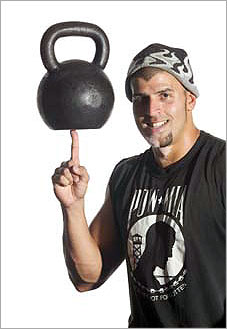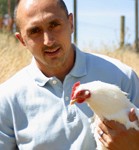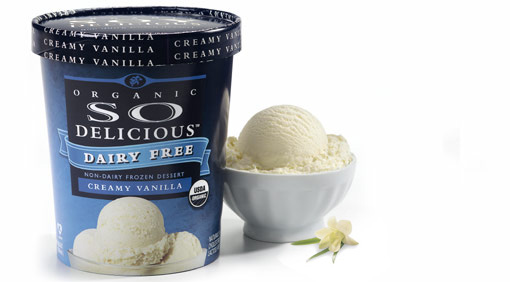Striving to eat clean, wholesome foods, and lead a healthy lifestyle, in the real world.
Tuesday, June 11, 2013
Labels:
food,
fruit,
healthy,
micronutrients,
nutritious,
raw,
vegetables
Monday, June 10, 2013
A great kid-friendly recipe from Kymberly Morgan, or poster from yesterday:
Parents, I've really done it this time. I've created the perfect recipe to incorporate an incredible amount of nutrition and fiber into your kids diets without them even knowing! It occurred to me when I was juicing this morning that I was throwing away a lot of nutrients in the pulp. That just didn't seem acceptable to me.
I've used the pulp from green vegetable juices, carrots, tomatoes, and beets to stir into stews, soups, and sauces in the past and they taste great! But today I had just juiced green apples, blueberries, strawberries, watermelon, ginger, kiwi, and spinach. I thought to myself that I couldn't possibly use this for soup or stew! It’s even a strange combo for muffins or bread!
And then it hit me. I decided to make a healthy and delicious fruit reduction sauce for kids to top their healthy pancakes with! They would never know there was spinach in it, because the berries out-flavor it. I quickly scooped the fruit pulp out of my juicer, and came up with this delicious and healthy recipe. I hope you and your children enjoy it as much as I did!
You can make this recipe in several varieties. Use any combo of fruits and veggies that you would like to incorporate into your child’s diet. Fruit and vegetable pulp is a wonderful source of vitamins, minerals, and fiber. If you also juice, now you have a recipe to utilize the wonderful pulp for! You can also freeze your pulp, and thaw it out for 30 minutes before you are ready to use it.
Ingredients:
¼ cup organic blueberries
3 large strawberries, diced
1 rounded tablespoon pure coconut oil
¼ cup shredded raw coconut
¼ to ½ cup of left over fruit pulp from juicing. The combo that I used today was as follows:
Breakfast Juice:
½ cup organic blueberries
6 large rinsed organic strawberries
2 large carrots, washed, stems removed
1 large Granny Smith apple, washed
1 cup seedless watermelon, rind removed
1 inch knob of ginger, peeled
2 whole kiwi fruits, peeled
2 cups organic spinach, rinsed and dried
½ cup purified water
Directions:
1) Make your breakfast juice in a juicer or blender. If using a blender or blender-type device (such as a Ninja or other device) then you will need cheesecloth or a nut-seed bag to strain the pulp. After juicing in a juice machine, set pulp aside. You can freeze the pulp for later use. If using a blender type device, strain your juice from the pulp inside of a nut-seed bag or by draping a large piece of cheesecloth over a mason jar, pouring juice over cheesecloth slowly, and squeezing out the cheesecloth carefully. Set pulp aside. Repeat until all of your pulp has been removed from the juice.
2) In a small skillet, melt coconut oil over medium heat. Add ½ of fresh or frozen organic blueberries, and the diced strawberries. Stir until incorporated with coconut oil.
3) Stir in raw shredded coconut. Mix well, continuing to sauté over medium heat. Add 1/8 cup filtered water to the pan and bring back to a slow boil. As soon as mixture starts to bubble again, add your fruit and spinach pulp. Stir until incorporated. Sauce will be noticeably thicker.
4) Lower heat and let the fruit sauce reduce. Stir occasionally. When sauce becomes thick and sticks to the backside of a spoon, you can either serve it over healthy pancakes at that point, or you can allow it to cool down and puree it. If you like it chunky like I do, then just serve it fresh out of the pan. Pureeing will give your “secret” fruit sauce more of a runny texture like syrup. If it becomes too thick, you can always add a couple of tablespoons of your actual morning juice, or water.
5) You could serve this over whole grain toast or English muffins. The possibilities are endless! Get creative with this recipe, and share it with your friends! You’re kids won’t know that there are healthy ingredients in their yummy “secret syrup,” and you can feel better about knowing what is going into their food. Enjoy!
Secret Fruit Sauce
Parents, I've really done it this time. I've created the perfect recipe to incorporate an incredible amount of nutrition and fiber into your kids diets without them even knowing! It occurred to me when I was juicing this morning that I was throwing away a lot of nutrients in the pulp. That just didn't seem acceptable to me.
I've used the pulp from green vegetable juices, carrots, tomatoes, and beets to stir into stews, soups, and sauces in the past and they taste great! But today I had just juiced green apples, blueberries, strawberries, watermelon, ginger, kiwi, and spinach. I thought to myself that I couldn't possibly use this for soup or stew! It’s even a strange combo for muffins or bread!
And then it hit me. I decided to make a healthy and delicious fruit reduction sauce for kids to top their healthy pancakes with! They would never know there was spinach in it, because the berries out-flavor it. I quickly scooped the fruit pulp out of my juicer, and came up with this delicious and healthy recipe. I hope you and your children enjoy it as much as I did!
You can make this recipe in several varieties. Use any combo of fruits and veggies that you would like to incorporate into your child’s diet. Fruit and vegetable pulp is a wonderful source of vitamins, minerals, and fiber. If you also juice, now you have a recipe to utilize the wonderful pulp for! You can also freeze your pulp, and thaw it out for 30 minutes before you are ready to use it.
Ingredients:
¼ cup organic blueberries
3 large strawberries, diced
1 rounded tablespoon pure coconut oil
¼ cup shredded raw coconut
¼ to ½ cup of left over fruit pulp from juicing. The combo that I used today was as follows:
Breakfast Juice:
½ cup organic blueberries
6 large rinsed organic strawberries
2 large carrots, washed, stems removed
1 large Granny Smith apple, washed
1 cup seedless watermelon, rind removed
1 inch knob of ginger, peeled
2 whole kiwi fruits, peeled
2 cups organic spinach, rinsed and dried
½ cup purified water
Directions:
1) Make your breakfast juice in a juicer or blender. If using a blender or blender-type device (such as a Ninja or other device) then you will need cheesecloth or a nut-seed bag to strain the pulp. After juicing in a juice machine, set pulp aside. You can freeze the pulp for later use. If using a blender type device, strain your juice from the pulp inside of a nut-seed bag or by draping a large piece of cheesecloth over a mason jar, pouring juice over cheesecloth slowly, and squeezing out the cheesecloth carefully. Set pulp aside. Repeat until all of your pulp has been removed from the juice.
2) In a small skillet, melt coconut oil over medium heat. Add ½ of fresh or frozen organic blueberries, and the diced strawberries. Stir until incorporated with coconut oil.
3) Stir in raw shredded coconut. Mix well, continuing to sauté over medium heat. Add 1/8 cup filtered water to the pan and bring back to a slow boil. As soon as mixture starts to bubble again, add your fruit and spinach pulp. Stir until incorporated. Sauce will be noticeably thicker.
4) Lower heat and let the fruit sauce reduce. Stir occasionally. When sauce becomes thick and sticks to the backside of a spoon, you can either serve it over healthy pancakes at that point, or you can allow it to cool down and puree it. If you like it chunky like I do, then just serve it fresh out of the pan. Pureeing will give your “secret” fruit sauce more of a runny texture like syrup. If it becomes too thick, you can always add a couple of tablespoons of your actual morning juice, or water.
5) You could serve this over whole grain toast or English muffins. The possibilities are endless! Get creative with this recipe, and share it with your friends! You’re kids won’t know that there are healthy ingredients in their yummy “secret syrup,” and you can feel better about knowing what is going into their food. Enjoy!
Sunday, June 9, 2013
For "Mostly Raw June" I've asked a few friends to do guest posts about their experiences with raw food, whether as a person who eats almost entirely raw food, or someone who just includes raw food in their regular diet, to reap the huge benefits of raw foods.
Today we have Kymberly Morgan, who has been including raw foods in her life for the past couple of years, and who recently decided to embark on a 3-day raw juice detox. Check it out!
 I returned home,
got out my juicer and gave it a good cleaning.
I then prepped & juiced enough produce for my first day of juice
fasting, which just so happened to be the next day! I figured I’d better be prepared to wake up
Saturday morning and have some healthy juice staring at me from the top of the
refrigerator shelf, so that I couldn't back out of my juice fast commitment!
I returned home,
got out my juicer and gave it a good cleaning.
I then prepped & juiced enough produce for my first day of juice
fasting, which just so happened to be the next day! I figured I’d better be prepared to wake up
Saturday morning and have some healthy juice staring at me from the top of the
refrigerator shelf, so that I couldn't back out of my juice fast commitment!
 In order to
properly prepare myself for my juicy road ahead, I decided to re-read Carla and Amacuba e-books, ‘101 JuiceFast Recipes’ and ‘How to Break a Juice Fast’ which I have uploaded to my
Kindle. They even have a new book out
now called ‘Juice 28! Your COMPLETE 28-Day Juice Detox Plan’ as well. Fabulous stuff here, everyone! Get on over to Raw Raw Life’s website and get
your copies now! (PDF versions are
available on their website, and Kindle format is available at Amazon.com)
In order to
properly prepare myself for my juicy road ahead, I decided to re-read Carla and Amacuba e-books, ‘101 JuiceFast Recipes’ and ‘How to Break a Juice Fast’ which I have uploaded to my
Kindle. They even have a new book out
now called ‘Juice 28! Your COMPLETE 28-Day Juice Detox Plan’ as well. Fabulous stuff here, everyone! Get on over to Raw Raw Life’s website and get
your copies now! (PDF versions are
available on their website, and Kindle format is available at Amazon.com)
 By the afternoon,
I was wondering why I was torturing myself with a juice detox. I was having
doubts that I would make it through the first day. I had previously committed to doing the juice
fast for 3 days. Somehow, this kept
weighing heavily on my mind while I doubted myself, and I couldn't help but
feel like a failure for wanting to give up so soon. 3 hours into my new juice fast, I was feeling
deprived. All I could think about what
was I could not have. I was not focusing
on the health ramifications of goodness that a fast does for your internal
organs, nor was I thinking about all of the beautiful juice prepared and
waiting for me in my refrigerator.
By the afternoon,
I was wondering why I was torturing myself with a juice detox. I was having
doubts that I would make it through the first day. I had previously committed to doing the juice
fast for 3 days. Somehow, this kept
weighing heavily on my mind while I doubted myself, and I couldn't help but
feel like a failure for wanting to give up so soon. 3 hours into my new juice fast, I was feeling
deprived. All I could think about what
was I could not have. I was not focusing
on the health ramifications of goodness that a fast does for your internal
organs, nor was I thinking about all of the beautiful juice prepared and
waiting for me in my refrigerator.
 From reading Carla
and Amacuba’s e-books, I knew that I still would need to ‘break’ my fast
properly. I've taken this entire past
week to ensure my fast is properly ended, and I have continued to eat mainly
raw food as well as incorporate juicing into my daily menu. Just this morning, I had my favorite juice
combo: beet, carrot, kale, green apple,
lemon, and ginger juice! It’s amazing! Thank you, Carla and Amacuba, for putting
together such healthful, nutritional information and encouragement in your
books as well as website information.
You two have done an excellent job with education here!
From reading Carla
and Amacuba’s e-books, I knew that I still would need to ‘break’ my fast
properly. I've taken this entire past
week to ensure my fast is properly ended, and I have continued to eat mainly
raw food as well as incorporate juicing into my daily menu. Just this morning, I had my favorite juice
combo: beet, carrot, kale, green apple,
lemon, and ginger juice! It’s amazing! Thank you, Carla and Amacuba, for putting
together such healthful, nutritional information and encouragement in your
books as well as website information.
You two have done an excellent job with education here!
Today we have Kymberly Morgan, who has been including raw foods in her life for the past couple of years, and who recently decided to embark on a 3-day raw juice detox. Check it out!
At the beginning of spring, I was feeling
rather inspired to take on another “Juicy June” detox fast, which is sponsored
by Carla Douglin’s ‘Raw Raw Life’ website, Facebook page and books. My friend and fellow Eat-Clean Diet
Ambassador Amacuba, who is also a co-writer and editor of Carla’s books, has inspired me
for the past couple of years to try juicing, eating raw, and purchase
appliances to make this experience not only easier, but fun as well.
Have you ever made spiral cut zucchini,
beets, carrots, cucumbers, or jicama?
Not only is it fun to use a spiral machine, but the outcome is
beautiful! Amacuba assisted me in
finding an inexpensive yet good quality spiral machine last year. Many terrific raw recipes have been created
in my kitchen with my machine since I purchased it. Raw vegetables are
transformed into beautiful spiral rings of tantalizing colors- orange, yellow,
green, white… What ever you are able to spiral cut, the results will be
pretty!
The variety of recipes you can create
with spiraled raw vegetables are plentiful.
I've made the most beautiful bowl of what appears to be vegetable pasta,
but is really just spiraled veggies.
I've created beautiful raw salads, fun soups for my grandchildren--not
raw, but hey, it’s totally healthy if made clean! I've created hors'doeuvres of spiraled zucchini wrapped around a chunk of roma tomato with a
small slice of mozzarella cheese inside of it.
Raw spiraled veggies make an incredibly delicious Chinese salad, and the
presentation is stunning!
Eating raw is a
great way to eat clean and detox your liver, colon, kidneys, gallbladder, and
lungs. Raw fruits and vegetables contain large amounts of water, vitamins, and
nutrients that are imperative for vital organ function. However, I decided to take detoxing my organs
to a whole new level this spring.
After watching
Carla Douglin’s ‘Raw Raw Life’ videos on YouTube, I decided to try a raw juice
fast/detox again this year. I've tried
them a few times in the past, but was never able to fully commit to, or stick
with a juice fast. Being an admitted
recovering over-eater and food-binger, I was highly skeptical the first time I
considered a juice fast.
I had many
concerns about fasting on juice, and the most obvious for a recovering
over-eater was the “deprivation” factor.
One would assume that, if only consuming juice, they would feel
deprived at the lack of chew-able foods.
This concerned me. The mere
thought of not being able to chew food gave me anxiety. When I feel “deprived” from food, my brain goes
into the automatic mental darkness of stress, and immediately starts talking to
me in McDonald’s language of salty, greasy French fries. I've been eating
clean for 3 years now; I have no intention of having cravings for a Big Mac!
To set “rules” and
deprive myself of food, my brain goes straight into that “have to have it”
mode. Sure, I have learned how to
control that urge through eating clean and being a member of Overeaters
Anonymous, but still, why would I want to put myself through that? After giving this very issue some serious
thought, I decided to do what I tell my Eat-Clean support group to do: Face
your fears and confront them head on.
It’s been said that you must do the thing you fear the most. Well, welcome to my biggest fear: Not being able to eat, chew, and enjoy real
food!
I decided that I
would give Raw Raw Life’s ‘Juicy June’ a try.
After all, what’s the worst that could happen? I might actually like it? Okay, I still wasn't convinced. But I did make the commitment, and I started
prepping for my juice fast last week. I
went to our local farmer’s market at the beach last Friday and purchased a
beautiful arrangement of produce--from beets to zucchini, kale, carrots,
cucumbers, and a variety of fruits and fresh ginger.
 I returned home,
got out my juicer and gave it a good cleaning.
I then prepped & juiced enough produce for my first day of juice
fasting, which just so happened to be the next day! I figured I’d better be prepared to wake up
Saturday morning and have some healthy juice staring at me from the top of the
refrigerator shelf, so that I couldn't back out of my juice fast commitment!
I returned home,
got out my juicer and gave it a good cleaning.
I then prepped & juiced enough produce for my first day of juice
fasting, which just so happened to be the next day! I figured I’d better be prepared to wake up
Saturday morning and have some healthy juice staring at me from the top of the
refrigerator shelf, so that I couldn't back out of my juice fast commitment! In order to
properly prepare myself for my juicy road ahead, I decided to re-read Carla and Amacuba e-books, ‘101 JuiceFast Recipes’ and ‘How to Break a Juice Fast’ which I have uploaded to my
Kindle. They even have a new book out
now called ‘Juice 28! Your COMPLETE 28-Day Juice Detox Plan’ as well. Fabulous stuff here, everyone! Get on over to Raw Raw Life’s website and get
your copies now! (PDF versions are
available on their website, and Kindle format is available at Amazon.com)
In order to
properly prepare myself for my juicy road ahead, I decided to re-read Carla and Amacuba e-books, ‘101 JuiceFast Recipes’ and ‘How to Break a Juice Fast’ which I have uploaded to my
Kindle. They even have a new book out
now called ‘Juice 28! Your COMPLETE 28-Day Juice Detox Plan’ as well. Fabulous stuff here, everyone! Get on over to Raw Raw Life’s website and get
your copies now! (PDF versions are
available on their website, and Kindle format is available at Amazon.com)
I went to bed
early Friday night, got a good night of sleep, and arose bright and early
Saturday morning with a “let’s do this!” attitude of fierceness! As Carla often says, “Juice early, juice
often.” I juiced early, and it was
good! It took me nearly an hour to
finish my first glass of juice. It was the “juice often” part of the equation
that I had trouble with.
 By the afternoon,
I was wondering why I was torturing myself with a juice detox. I was having
doubts that I would make it through the first day. I had previously committed to doing the juice
fast for 3 days. Somehow, this kept
weighing heavily on my mind while I doubted myself, and I couldn't help but
feel like a failure for wanting to give up so soon. 3 hours into my new juice fast, I was feeling
deprived. All I could think about what
was I could not have. I was not focusing
on the health ramifications of goodness that a fast does for your internal
organs, nor was I thinking about all of the beautiful juice prepared and
waiting for me in my refrigerator.
By the afternoon,
I was wondering why I was torturing myself with a juice detox. I was having
doubts that I would make it through the first day. I had previously committed to doing the juice
fast for 3 days. Somehow, this kept
weighing heavily on my mind while I doubted myself, and I couldn't help but
feel like a failure for wanting to give up so soon. 3 hours into my new juice fast, I was feeling
deprived. All I could think about what
was I could not have. I was not focusing
on the health ramifications of goodness that a fast does for your internal
organs, nor was I thinking about all of the beautiful juice prepared and
waiting for me in my refrigerator.
Thank goodness
Carla posted YouTube videos pertaining to juice fasting! She explained that I was feeling ‘mentalhunger,’ and not ‘physical hunger.’ She
was right! Once I took my mind off of
the feelings of food deprivation from what I could not have, I began to think about all of the things that I could have--beautiful, delicious,
healthy raw juice made in my own kitchen;
a cleansed colon, liver, stomach, gallbladder, kidneys, lungs; clear skin, improved vision, clean and
improved blood. There are so many
positive things that I was providing for my body by committing to a juice fast
detox. I began to focus on the healthy
elements instead of the mental anguish of deprivation.
I decided to get
out of the house, and re-focus my thoughts and energy. It took my mind off of ‘myself,’ and allowed
me to get some fresh air and mild exercise.
That first night, I slept well. As a matter of fact, I slept very well.
I woke up ready to juice the next morning, day 2 of my juice fast, and felt
energetic and alive. It was at this point that I knew my body was responding
well, and I decided to continue with the fast.
I did experience weak periods throughout the day, and needed to rest a
lot. I had a headache through the
majority of the detox, and my skin broke out horrifically.
Those are the
exact signs that your body is properly detoxing, so I knew that I just needed
to continue on and wait it out, which is exactly what I did. Day 3 was pretty easy, and my detox symptoms
began to dissipate. I felt great by the
time I went to bed that night, and gave myself a good talking to about doubt
and fear. I felt so good the next
morning that I decided to have a huge glass of freshly made juice for
breakfast, even though my juice fast detox was over.
 From reading Carla
and Amacuba’s e-books, I knew that I still would need to ‘break’ my fast
properly. I've taken this entire past
week to ensure my fast is properly ended, and I have continued to eat mainly
raw food as well as incorporate juicing into my daily menu. Just this morning, I had my favorite juice
combo: beet, carrot, kale, green apple,
lemon, and ginger juice! It’s amazing! Thank you, Carla and Amacuba, for putting
together such healthful, nutritional information and encouragement in your
books as well as website information.
You two have done an excellent job with education here!
From reading Carla
and Amacuba’s e-books, I knew that I still would need to ‘break’ my fast
properly. I've taken this entire past
week to ensure my fast is properly ended, and I have continued to eat mainly
raw food as well as incorporate juicing into my daily menu. Just this morning, I had my favorite juice
combo: beet, carrot, kale, green apple,
lemon, and ginger juice! It’s amazing! Thank you, Carla and Amacuba, for putting
together such healthful, nutritional information and encouragement in your
books as well as website information.
You two have done an excellent job with education here!
The final results
of my juice fast are remarkable. I’ve
lost 4 pounds, I’m sleeping fabulously at night, I’m waking up with energy and
strength, and my stomach issues of bloating and gas have gone away. My skin has cleared up, and I feel much
lighter. I’m so happy with the outcome
from my 3 day juice fast, that I am recommitting to another juice fast soon- a
5 day juice fast! Eventually, I’d like
to work my way up to a full 28 day juice detox fast. But for me personally, I know that is exactly
what I must do: I must work my way up to it! For me, it’s all about small steps, one day at
a time. Won’t you give it a try,
too? Your body and mind will surely thank
you for it!
~Kymberly Morgan
Saturday, June 1, 2013
I found this interesting article today about plant-based eating, and thought I'd share it. It's from
Precision Nutrition.
Precision Nutrition.
Plant-based eating is undiscovered territory for most North Americans.
We’re used to tall glasses of moo juice, grilled chicken salads at restaurants, big omelets, and whey protein shakes. (And that’s the most nutritionally-conscious of us. Many folks still think vegetables mean French fries, or perhaps the anemic wisp of iceberg lettuce on a bacon cheeseburger.)
When folks decide to add more plants to be “healthier” or “more environmentally friendly”, that addition might include refined grains, processed soy, Twizzlers, and beer. While this kind of food swapping is usually better for animals, and — depending on how these pseudo-foods were produced — better for the planet, it might not be so good for our health and body composition.
This can lead to plant-based eating confusion. What’s “good”? What’s “healthy”? Whatreally benefits animals, the planet, and your wellbeing?
Luckily, more and more coaches and experts understand plant-based eating. I gathered some of the best and brightest to discuss the topic.
Our panel
 | Jon Hinds runs Monkey Bar Gym in Madison, WI. |
 | Nathane Jackson is an NSCA certified strength & conditioning coach and kettlebell trainer specialist in Toronto, Canada. Nathane is a pro fitness model, physique competitor, and fitness personality. |
 | Mike Mahler is a writer, strength trainer, and kettlebell instructor in Las Vegas, NV. |
 | Jack Norris is a Registered Dietitian and the President and co-founder of Vegan Outreach. |
 | Jeff Novick holds an MS and RD, is Vice President for Executive Health Exams International, lectures at the McDougall Program in Santa Rosa, California, and serves as an Adjunct Professor in the School of Health Sciences for Kaplan University. |
 | John Pierre is a nutrition and fitness consultant specializing in geriatrics, nutrition, fitness, women’s empowerment, green living, and cognitive retainment and improvement. |
Q. Why do some folks feel plant-based eating doesn't provide enough protein?
Jon Hinds: Because we learn that meat, milk, etc. are the “protein” foods. Don’t worry, plants have protein!
Jack Norris: Indeed, many people do not even know that plants contain any protein at all. How they think vegetarians survive is an interesting question!
Nathane Jackson: The bodybuilding influence has dominated most mainstream fitness magazines for decades. This approach tells us to consume large quantities of animal protein in order to build muscle. But we need to consider other issue in these extra-large physiques: performance enhancing drugs; mucus build-up from excessive animal protein consumption; and for the most part non-functional movement. The general public reads these magazines and get brainwashed into feeling like they require high levels of animal protein (and isolation exercises, but that’s a topic for another time).
John Pierre: Most people aren’t familiar with plant-based diets and the research supporting them. Look no further than athletes who eat plant-based. Eat properly, and you’ll get all the protein you need.
Mike Mahler: Fitness magazines often recommend 1-2 grams of protein per pound of bodyweight. As a result, people think they require a lot of protein.
However, I don’t think people need this much. Instead, 1 gram of protein per kilogram of bodyweight is a good starting point. Beyond this, you could add 30-40 grams each day if you are in a phase of intense training.
Using this approach, a 200 pound athlete would take in around 90 – 130 grams of protein each day, which can easily be achieved on a 100% plant-based diet. Building muscle and losing bodyfat comes from creating an optimal hormonal environment, not from over-consuming protein.
Plants have protein, and with a well-chosen diet you can get everything you need, even if you’re an athlete.
Q. Joe/Jane Meat Eater decides to start eating more plant-based. Where will Joe/Jane likely go wrong?
Hinds: Joe/Jane won’t eat enough nutritious foods, and then they’ll get tired, weak, and think plant-based eating isn’t for them.
Jackson: They’ll consume excessive amount of nuts, beans, and plant protein powders (neglecting fresh vegetables and fruits – the foundation of a nutrient rich eating plan). As an athlete I do consume plant protein powders such as Vega andSunwarrior, but I’ve seen folks use such products at every meal to adhere to the “meat-eating bodybuilding influence” of 30 grams of protein per meal.
Novick: Eating too many refined and processed “vegetarian” foods. The real benefit from “plant-based” comes when the diet is centered on whole unrefined/unprocessed fruits, vegetables, intact whole grains, and legumes with the addition of a few nuts/seeds.
Norris: When some people eat 100% plant-based, they also give up added fats (among other things). They end up with a very low fat diet and sometimes not feeling so great. They then go back to eating meat for the “protein,” not realizing that many types of meat are 50% or more fat. They feel better with the meat and chalk it up to the protein. Often it was really the added fat that made them feel better, not the protein; they could have gotten a similar effect by adding more fat to their plant-based diet.
The real benefit from ‘plant-based’ comes when the diet is centered on whole unrefined/unprocessed fruits, vegetables, intact whole grains, and legumes with the addition of a few nuts/seeds.
Mahler: Yes, fat consumption is generally too low or from poor sources. Or people eat excessive amounts of grains, like pasta, bread, cereal, etc. People need a balance of protein, healthy fats, and low glycemic carbohydrates at each meal from whole food sources.
And avoid “fake meat” products. These products are often loaded with garbage ingredients such as wheat gluten, soy protein isolate, tons of sodium, and other chemical derivatives.
Norris: On the other hand, plant-based diets can fall short on the amino acid lysine if someone is avoiding all legume-based foods. Legume-based foods include:
- tofu;
- tempeh;
- soymilk; and
- other soy products; peanuts; beans, lentils, and peas.
These foods are the highest in lysine. If you don’t eat any of these foods regularly (at least 2 servings per day – 1 serving typically being 1/2 cup cooked or 1 cup of soymilk), then you should make sure you’re getting plenty of servings of the few other high-lysine foods in the plant kingdom – quinoa, pistachios, and cashews.
Many folks simply eliminate meat from their diet, but don’t add in more healthy options. Or they go overboard with what they think are “healthy options”: processed foods, refined grains, and protein powders.
Fruits, veggies, nuts, seeds, and legumes should provide the foundation of a plant-based diet.
Q. Some folks are concerned with controlling carb intake and often get scared away from plant-based eating. What do you tell them?
CARB TYPE
Hinds: We’re told carbs are “bad,” so many folks resort to eating only meat and vegetables to lose body fat. “Carbs” in general aren’t the problem; it’s the source of the carbs that matters. Some plant-based eaters consume high amounts of processed carbs and end up looking/feeling like trash. This gives the plant-based eating population a bad rep.
Novick: Over 90% of the carbs consumed in America are highly refined, highly processed, and mostly in the form of refined flour and sugar. This is the problem. Avoid these.However, carbs in the form of fresh fruits, vegetables, starchy vegetables, intact whole grains and legumes are the healthiest foods for us, and should be the center of any healthy diet. This is a very important distinction.
Hinds: Eat strong plant foods like wild rice, sweet potatoes, millet, quinoa, amaranth, etc. These kinds of carb-dense foods aren’t causing body fat problems and disease.
CARB TIMING
Jackson: Consume the majority of your carbohydrate-dense foods (root vegetables and grains) earlier in the day and/or around workout times. If you work out in the evening, surround your workout with a combination of simple and complex carbohydrates to maximize workout potential and recovery.
Pierre: Yes, complex carb sources found in whole foods will help control insulin response; save simple carbs for after intense workouts.
Avoid processed carbs; look for better sources such as whole grains and tubers. Stay active, and consume most of your carbs around your workouts.
Q. Some folks want to gain muscle/strength and fuel high levels of performance. What do you suggest they do to get enough nutrient dense food each day?
Hinds: We have a guideline called the MBG Hand Plan: Eat only when hungry, eat only until satisfied, and drink lots of water.
- To lose fat, eat 2 meals and 3 snacks per day.
- To maintain body composition, consume 3 meals and 2 snacks per day.
- To gain muscle, eat 5 meals per day.
Make up these meals from nutrient dense foods like veggies, fruits, raw nuts and seeds, legumes and then grains (in that order). Eating like this consistently will lead to amazing results.
SMOOTHIES
Jackson: Try some meals in the form of smoothies and juices for easier digestion and assimilation.
Pierre: Add healthy fats like flax or walnuts. Add veggies to each meal, including your smoothie. And if you have protein anxiety, use a pea or brown rice protein (or a blend like Vega).
Mahler: I like Sun Warrior Rice Protein, Olympian Labs Pea Protein, and Manitoba Harvest Hemp Protein.I would also suggest adding coconut oil or coconut milk. Coconut is a great source of medium chain fats, which the body uses well. Coconut oil in a protein shake two hours before a workout will help to ensure that you have enough energy to crush it. Having a balance of protein, fat, and carbohydrates at each meal will balance energy levels throughout the day.
Norris: And possibly 3-5 grams of creatine if you’re doing explosive sports like power lifting or sprinting.
Eat a variety of nourishing foods. Eat in accordance with your appetite and goals. And make friends with your blender.
Q. Soy – any thoughts?
Pierre: Soy is a legume, it’s not mystical or magical. Don’t hide from it nor hold it above any other legume.
HOW MUCH?
Hinds: Soy’s received a lot of bad press. But really, in order to notice any negative effect, your intake of soy has to be huge! Occasional soy from whole food sources (tempeh, edamame, etc.) is no problem.
Novick: Soy is highly over-blown, over-hyped and over-promoted in the USA. In Southeast Asia, the average intake is about 2 oz a day, or the equivalent of about 7-9 grams of soy protein. Limit overall soy consumption. You can get all the benefits of soy from other beans without the potential health concerns.
WHAT ABOUT “FAKE-ON” OR “SOYLONEY”?
Hinds: When people first start transitioning to plant-based eating, using “fake soy meat” products is fine. Beyond that initial transition period I encourage folks to eat whole foods as much as possible, and not rely on these fake substitutes.
Jackson: Personally, I am not a fan of soy. However, people can get away with including non-GMO (genetically modified) soy products on occasion. But I do warn them about the potential health problems from eating fake products such as soy burgers, soy milk, and soy cheese.
Novick: Avoid all the highly processed forms of soy. Edamame = good; isolated soy protein = bad. Tempeh = good; soy energy bars = bad.
Mahler: Not all soy products are created equal. Fermented products, such as natto and tempeh, are absorbed more efficiently and don’t seem to block mineral absorption like other soy products.

- Still not really the healthiest choice.
WHAT TO WATCH FOR
Mahler: After the soy scare many years ago, a lot of research was done to see if soy does in fact lower testosterone and raise estrogen levels. The results are still inconclusive. The theory that phytoestrogens in soy lower testosterone has not been confirmed. This doesn’t mean that one should go crazy on soy as many people have soy sensitivities without realizing it, and you could develop sensitivities if high levels of soy are consumed each day. Soy can have negative effects on the thyroid, so anyone with thyroid issues should question their soy use.
Choose soy foods carefully and in moderation, if at all.
Dos and don’ts
If you’re considering moving towards a plant-based diet, or just want some more plant-based choices, here are the experts’ tips:
- DO choose your protein sources carefully.
- DO aim for about 1 gram of protein per kg of bodyweight; add 30-40 grams each day if you are in a phase of intense training.
- DON’T get your nutrition information from bodybuilding magazines. (May we recommend Precision Nutrition V3.0?)
- DON’T just cut things out without adding healthy alternatives in.
- DO get enough fat.
- DO eat a variety of whole foods, especially lots of vegetables and fruits.
- DON’T consume too many processed foods (including “healthy” protein powders and processed soy products).
- DO stay active.
- DO use your body’s hunger cues to guide you. If you want to lose fat, eat a little less than you’d normally want. If you want to gain mass, eat a little more.
Subscribe to:
Posts (Atom)



